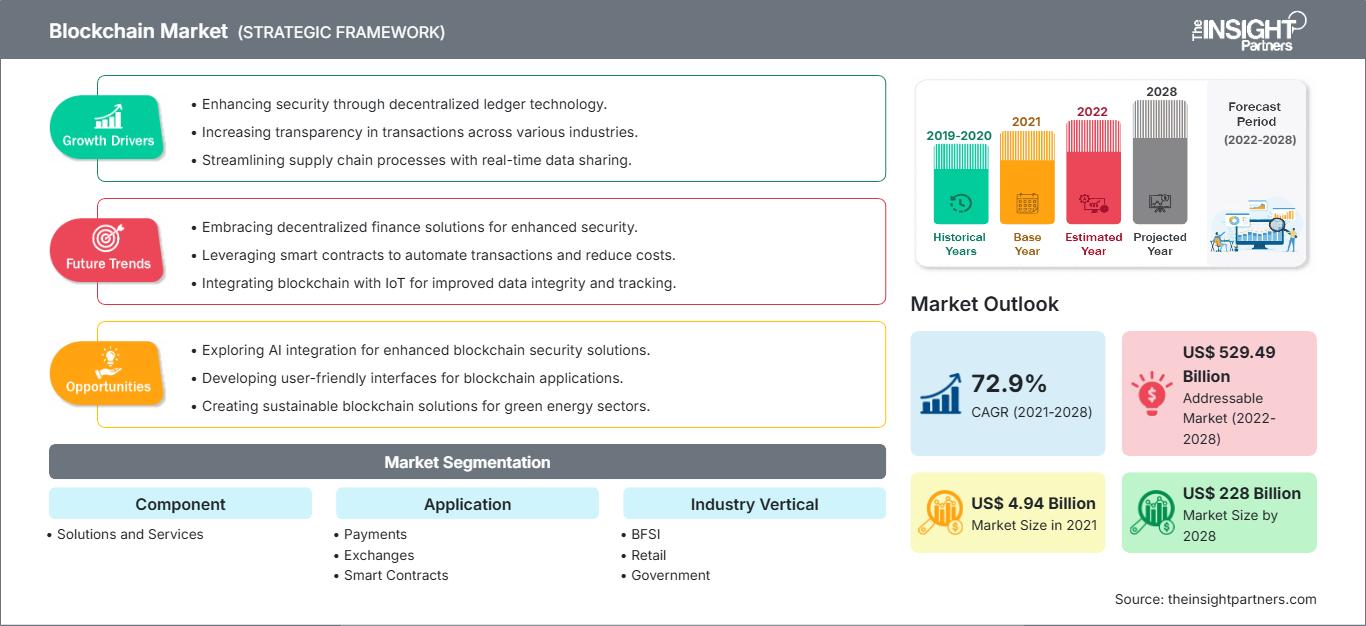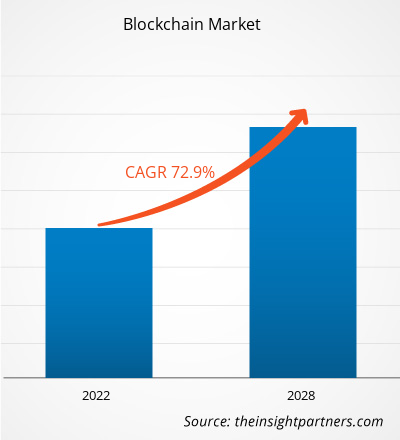Der Blockchain-Markt soll von 4.935,0 Millionen US-Dollar im Jahr 2021 auf 227.996,6 Millionen US-Dollar im Jahr 2028 wachsen; von 2021 bis 2028 wird ein CAGR von 72,9 % geschätzt. Die Blockchain-Technologie und ihre Anwendungen im Banken-, Finanzdienstleistungs- und Versicherungssektor (BFSI) haben in den letzten Jahren viel Aufmerksamkeit auf sich gezogen, hauptsächlich aufgrund ihrer Fähigkeit, die Grundlagen und Geschäftsmodelle bestehender Branchen zu transformieren. Abgesehen von Kryptowährungsanwendungen liegen die anderen wichtigen praktischen Anwendungen von Blockchain derzeit noch im Banken- und Finanzsektor. Verschiedene Unternehmen und Institutionen entwickeln jedoch derzeit rasch Blockchain-basierte Lösungen zur Lösung komplexer Geschäftsprobleme. Im Allgemeinen ist Blockchain eine Untermenge einer umfassenderen Distributed-Ledger-Technologie (DLT) und kombiniert drei wichtige Konzepte: Kryptografie, Smart Contracts und Distributed-Ledger-Design. Die Distributed-Ledger-Technologie (DLT) ist ein schnell wachsender Ansatz zur Aufzeichnung und Freigabe von Daten über verschiedene Datenspeicher/Ledger hinweg. DLT erleichtert die Aufzeichnung, Freigabe und Synchronisierung von Transaktionen und Daten über ein verteiltes Netzwerk verschiedener Netzwerkteilnehmer.
Der globale Blockchain-Markt wird in naher Zukunft voraussichtlich ein sehr starkes Wachstum verzeichnen. Wichtige Wachstumsfaktoren sind die umfassende Einführung von Blockchain-Lösungen im BFSI-Sektor, Vorteile wie höhere Transparenz, höhere Betriebseffizienz und erhebliche Kosteneinsparungen sowie die Zunahme innovativer Start-ups. Im Prognosezeitraum werden Trends wie zunehmende staatliche Unterstützung und Initiativen sowie die Kombination von Blockchain und künstlicher Intelligenz für fortschrittliche Anwendungen voraussichtlich spannende Möglichkeiten für die Akteure im Blockchain-Markt bieten.
Passen Sie diesen Bericht Ihren Anforderungen an
Sie erhalten kostenlos Anpassungen an jedem Bericht, einschließlich Teilen dieses Berichts oder einer Analyse auf Länderebene, eines Excel-Datenpakets sowie tolle Angebote und Rabatte für Start-ups und Universitäten.
Blockchain-Markt: Strategische Einblicke

- Holen Sie sich die wichtigsten Markttrends aus diesem Bericht.Dieses KOSTENLOSE Beispiel umfasst Datenanalysen, die von Markttrends bis hin zu Schätzungen und Prognosen reichen.
Auswirkungen der COVID-19-Pandemie auf den Blockchain-Markt
Während die COVID-19-Pandemie Organisationen weltweit vor erhebliche Herausforderungen stellte, ist der Blockchain-Markt während der Krise stetig gewachsen. Besonders wichtig ist, dass Mitarbeiter im Gesundheitswesen während der Epidemie dazu übergegangen sind, Patienten per Chat, E-Mail, Telefon und Videokonferenzen aus der Ferne zu behandeln und so die Ausbreitung des Virus zu verhindern. Der Einsatz von Penetrationstests für sichere Online-Transaktionen und Gesprächsdaten nahm daher zu. Die Nutzung des Blockchain-Marktes durch verschiedene Unternehmen, um optimale Sicherheit in einem chaotischen Umfeld zu gewährleisten, ist ebenfalls ein entscheidender Faktor für den Blockchain-Markt. Die COVID-19-Pandemie hat alle Bereiche der Gesellschaft beeinflusst, einschließlich Einzelpersonen und Unternehmen. Das Internet-Ökosystem hat weltweit zunehmend an Bedeutung gewonnen. Die Abhängigkeit von Online-Unternehmen hat durch den COVID-19-Ausbruch dramatisch zugenommen. Das Internet wird von Finanz- und Gesundheitsdienstleistungen, dem Gesundheitswesen und den Biowissenschaften, der Fertigung, dem Einzelhandel, Transport und Logistik sowie anderen Branchen genutzt, um wichtige Dienstleistungen für Verbraucher bereitzustellen. Die Nachfrage nach Blockchain ist bei den Anbietern stark gestiegen. Verschiedene Regierungen und Regulierungsbehörden haben sowohl öffentliche als auch private Organisationen im Zuge der COVID-19-Pandemie gezwungen, neue Techniken der Telearbeit und der Wahrung sozialer Distanz zu akzeptieren. Seitdem sind digitale Geschäftspraktiken und die Nutzung von E-Mails auf Heimservern für eine Vielzahl von Unternehmen zum neuen Geschäftskontinuitätsplan (BCP) geworden. Sie erhalten kostenlos Anpassungen an jedem Bericht, einschließlich Teilen dieses Berichts oder einer Analyse auf Länderebene, eines Excel-Datenpakets sowie tolle Angebote und Rabatte für Start-ups und Universitäten.
Blockchain-Markt: Strategische Einblicke

- Holen Sie sich die wichtigsten Markttrends aus diesem Bericht.Dieses KOSTENLOSE Beispiel umfasst Datenanalysen, die von Markttrends bis hin zu Schätzungen und Prognosen reichen.
Markteinblicke in die Blockchain
Führende Branchen weltweit – darunter Banken, Finanzdienstleistungen und Versicherungen (BFSI), Einzelhandel, Logistik und Transport, Gesundheitswesen, Automobilindustrie, Medien und Unterhaltung sowie Organisationen des öffentlichen Sektors – integrieren zunehmend disruptive Technologien wie Blockchain, künstliche Intelligenz (KI), das Internet der Dinge (IoT), Big Data und prädiktive Analytik in ihre Betriebsabläufe. Unter diesen hat sich Blockchain als transformative Kraft herausgestellt und erfreut sich aufgrund ihrer nachweislichen Fähigkeit, mehr Transparenz zu schaffen, die Betriebseffizienz zu verbessern und Transaktions- und Verwaltungskosten zu senken, einer breiten Akzeptanz. Die beschleunigte Einführung von Blockchain wird durch eine wachsende Zahl erfolgreicher Implementierungen und Pilotprogramme untermauert, die praktische Vorteile belegen. Unternehmen stehen unter zunehmendem Druck, in einer sich schnell entwickelnden digitalen Wirtschaft wettbewerbsfähig zu bleiben. Blockchain bietet eine dezentrale, sichere und manipulationssichere Infrastruktur, die diesen Anspruch unterstützt. Unternehmen erkennen zudem den strategischen Wert von Blockchain, da es agilere, datengesteuerte Abläufe ermöglicht und das Vertrauen aller Beteiligten stärkt. Im Finanzdienstleistungssektor findet Blockchain breite Anwendung in Bereichen wie grenzüberschreitenden Zahlungen, Kapitalmärkten, Handelsfinanzierung, Investment- und Vermögensverwaltung sowie Wertpapierclearing und -abwicklung. Die Fähigkeit, traditionell manuelle, zeitintensive Prozesse zu rationalisieren und zu automatisieren, reduziert die Abhängigkeit von Zwischenhändlern, verkürzt die Bearbeitungszeiten erheblich und minimiert das Fehler- und Betrugsrisiko. Darüber hinaus nutzen Organisationen, die mit sensiblen Daten umgehen – wie das Gesundheitswesen und Behörden – Blockchain, um Datenintegrität und sicheren Informationsaustausch zu gewährleisten. Durch unveränderliche Prüfpfade und Echtzeit-Datenzugriff verbessert Blockchain die Einhaltung gesetzlicher Vorschriften und stärkt das Vertrauen aller Teilnehmer in jedem Marktökosystem. Die Senkung der Betriebskosten bleibt ein zentrales Ziel für Unternehmen weltweit. Blockchain trägt zu diesem Ziel bei, indem es die Effizienz von Arbeitsabläufen optimiert und redundante Verifizierungsprozesse eliminiert. Da Unternehmen weiterhin Strategien zur digitalen Transformation verfolgen, ist Blockchain ein wichtiger Innovationstreiber. Sie ermöglicht ein verbessertes Kundenerlebnis durch schnellere Services, höhere Datengenauigkeit und verbesserte Verantwortlichkeit und positioniert sich so als langfristiger Vorteil für die Geschäftsstabilität und Skalierbarkeit.Einblicke in das Komponentensegment
Basierend auf den Komponenten lässt sich der Blockchain-Markt in Services und Lösungen unterteilen. Das Lösungssegment war führend im Blockchain-Markt. Die zunehmende Akzeptanz von Blockchain-Lösungen aufgrund ihrer Fähigkeit, mehr Transparenz im Finanztransaktionsmanagement in Bitcoin zu bieten, sowie die zunehmende Digitalisierung treiben den Blockchain-Markt voran. Kunden können die Blockchain-Plattform des Marktes nutzen, um private, öffentliche und konsortiumbasierte Blockchain-Umgebungen zu erstellen und ihre eigenen Blockchain-Anwendungen und -Lösungen zu entwickeln. Menschen, Produkte, Apps und Services können über das Blockchain-Netzwerk, Cloud-Anbieter und Unternehmen mithilfe dieser Plattformen interagieren.BlockchainRegionale Einblicke in den Blockchain-Markt
Die Analysten von The Insight Partners haben die regionalen Trends und Faktoren, die den Blockchain-Markt im Prognosezeitraum beeinflussen, ausführlich erläutert. In diesem Abschnitt werden auch die Blockchain-Marktsegmente und die geografische Lage in Nordamerika, Europa, dem asiatisch-pazifischen Raum, dem Nahen Osten und Afrika sowie Süd- und Mittelamerika erörtert.
Umfang des Blockchain-Marktberichts
| Berichtsattribut | Einzelheiten |
|---|---|
| Marktgröße in 2021 | US$ 4.94 Billion |
| Marktgröße nach 2028 | US$ 228 Billion |
| Globale CAGR (2021 - 2028) | 72.9% |
| Historische Daten | 2019-2020 |
| Prognosezeitraum | 2022-2028 |
| Abgedeckte Segmente |
By Komponente
|
| Abgedeckte Regionen und Länder | Nordamerika
|
| Marktführer und wichtige Unternehmensprofile |
|
Dichte der Blockchain-Marktakteure: Ihre Auswirkungen auf die Geschäftsdynamik verstehen
Der Blockchain-Markt wächst rasant, angetrieben durch die steigende Endverbrauchernachfrage aufgrund von Faktoren wie sich entwickelnden Verbraucherpräferenzen, technologischem Fortschritt und einem stärkeren Bewusstsein für die Produktvorteile. Mit steigender Nachfrage erweitern Unternehmen ihr Angebot, entwickeln Innovationen, um den Verbraucherbedürfnissen gerecht zu werden, und nutzen neue Trends, was das Marktwachstum weiter ankurbelt.

- Holen Sie sich die Blockchain-Markt Übersicht der wichtigsten Akteure
Einblicke in Branchensegmente
Blockchain ist ein verteiltes Hauptbuch, das eine große Menge digitaler Transaktionen unabhängig vom Standort automatisch verifizieren und aufzeichnen kann. Da Start-ups die Blockchain-Technologie nutzen, um mehr Transparenz im digitalen Informationsnetzwerk zu schaffen, steigern sie die Bekanntheit der Blockchain-Technologie in verschiedenen Sektoren. Basierend auf den Branchen ist der globale Blockchain-Markt in die Bereiche Finanzwesen, Einzelhandel, öffentliche Verwaltung, Transport & Logistik, Gesundheitswesen, Automobilindustrie, Medien & Unterhaltung und Sonstiges. Das Segment Sonstiges umfasst Fertigung, Immobilien, Energie- und Versorgungsunternehmen, Telekommunikation und Sport. Die Akteure des Blockchain-Marktes konzentrieren sich auf Produktinnovationen und -entwicklungen durch die Integration fortschrittlicher Technologien und Funktionen, um wettbewerbsfähig zu bleiben. So schlossen sich beispielsweise Carrefour und Nestlé 2019 mit IBM zusammen, um Blockchain-Technologie im Lebensmittelbereich einzusetzen. Die Partnerschaft würde einen schnellen Ausbau eines Blockchain-basierten Netzwerks ermöglichen, das mehr Transparenz in die globale Lebensmittelversorgungskette von Einzelhändlern, Erzeugern, Großhändlern, Verarbeitern, Distributoren und Herstellern bringt.Blockchain-Markt – Unternehmensprofile
IBM Corporation, Microsoft Corporation, Accenture, Amazon, SAP SE, Hewlett Packard Enterprise Development LP (HPE), Oracle Corporation, Intel Corporation, Ripple, Bitfury Group- Historische Analyse (2 Jahre), Basisjahr, Prognose (7 Jahre) mit CAGR
- PEST- und SWOT-Analyse
- Marktgröße Wert/Volumen – Global, Regional, Land
- Branchen- und Wettbewerbslandschaft
- Excel-Datensatz
Aktuelle Berichte
Erfahrungsberichte
Grund zum Kauf
- Fundierte Entscheidungsfindung
- Marktdynamik verstehen
- Wettbewerbsanalyse
- Kundeneinblicke
- Marktprognosen
- Risikominimierung
- Strategische Planung
- Investitionsbegründung
- Identifizierung neuer Märkte
- Verbesserung von Marketingstrategien
- Steigerung der Betriebseffizienz
- Anpassung an regulatorische Trends




















 Kostenlose Probe anfordern für - Blockchain-Markt
Kostenlose Probe anfordern für - Blockchain-Markt